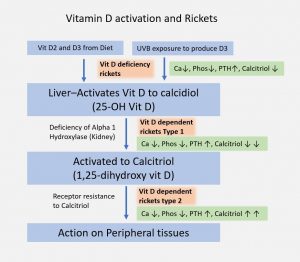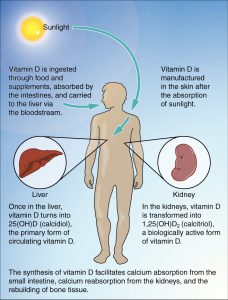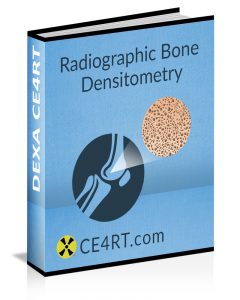Rickets and Osteomalacia Causes

Rickets and osteomalacia are disorders of bone that are a result of insufficient levels of vitamin D. This vitamin is essential for adequate mineralization of bone. Therefore, deficiency of vitamin D results in soft and fragile bones. This deficiency is one of the most important rickets and osteomalacia causes. Rickets affects children and osteomalacia affects adults. These bone diseases are relatively uncommon in the United States because they can be easily prevented by ensuring adequate vitamin D in the body. However, understanding these diseases is important because children and adults who develop rickets and osteomalacia suffer devastating consequences.
Radiologic technologists may often come across adults and children with bone diseases. Our 23-credit ARRT®
-recognized course on bone densitometry has comprehensive information on diseases of the bones and their diagnosis and treatment.
Rickets and Osteomalacia Difference
Rickets is associated with delay in the deposition of minerals in the child’s growing bones. This results in skeletal deformities, the most obvious of which is bowed legs, which is a classic sign of rickets. The equivalent disease in adults is osteomalacia. In both adults and children, rickets and osteomalacia causes are similar. However, since the bones of adults are no longer growing in length, the defective mineralization does not lead to deformities in the skeleton. Instead, osteomalacia leads to a high risk of fractures, especially in weightbearing bones such as those of the feet, hips, and pelvis. In addition, children and adults who suffer from rickets and osteomalacia often complain of severe weakness in the muscles as well as bone pain.
Rickets and Osteomalacia Causes
Most often, rickets and osteomalacia are the result of abnormalities in the individual’s environment, such as restricted exposure to sunlight. Rarely, these disorders are inherited and are the result of a mutation in the gene that codes for the enzyme which converts vitamin D to its active form. A mutation in the gene that regulates the vitamin D receptor can also have the same effect. In addition, disorders in which there is a loss of large amounts of phosphorus from the body can lead to the development of osteomalacia. Such disorders may be genetic or they may be the result of a tumor that affects the transport of phosphorus in the kidney. These rickets and osteomalacia causes are very rare.
Rickets and Osteomalacia: Role of Vitamin D

Vitamin D is manufactured by the body when the skin is exposed to sunlight. Therefore, the most common cause of vitamin D deficiency is a reduced exposure to the sun. In particular, people who live in northern latitudes are prone to vitamin D deficiency because the sun, particularly in the winter months, is either absent or too weak to allow the skin to form vitamin D. This problem is compounded in immigrants who move from sunnier areas of the world to colder countries at northern latitudes. The pigmented skin of these immigrants has an effect on vitamin D levels. Moreover, if cultural traditions lead these individuals to habitually cover themselves, their exposure to sunlight is further restricted. Therefore, insufficient exposure to sunlight is one of the most common and easily modifiable rickets and osteomalacia causes.

Children who do not play outdoors and adults who are house-bound, due to a chronic illness or limited mobility, for instance, are at risk of vitamin D deficiency. In addition, people with disorders of the gastrointestinal tract such as malabsorption syndromes or people who have undergone small bowel resection or gastrectomy are at high risk of vitamin D deficiency because of the reduced absorption of vitamin D from dietary intake.
Other Causes of Rickets and Osteomalacia
In addition to vitamin D deficiency, rickets and osteomalacia causes include a deficiency of phosphate in the body. A form of the disease called hypophosphatemic rickets is genetic and is inherited as an X-linked disorder. More commonly, however, the phosphate deficiency that leads to rickets and osteomalacia is the result of non-genetic factors. The kidneys in some individuals have a reduced ability to retain phosphate, putting them at risk of phosphate deficiency. Diseases which damage the renal tubules can lead to this condition as this is the site where phosphate is reabsorbed by the kidneys.
In addition, diet can play a role in the development of phosphate deficiency. People who consume large amounts of aluminum hydroxide in antacids may suffer from phosphate deficiency due to the absorption of dietary phosphate being prevented by these drugs. Certain drugs are known to interfere with bone mineralization or phosphate absorption. Rickets can develop as a result of inherited or acquired defects in the kidney tubule that affect acid secretion. Finally, some tumors secrete substances that promote the loss of phosphate from the body, leading to what is known as oncogenic or tumor-induced osteomalacia. These are relatively rare rickets and osteomalacia causes.
Visit here for radiography continuing education credits.
